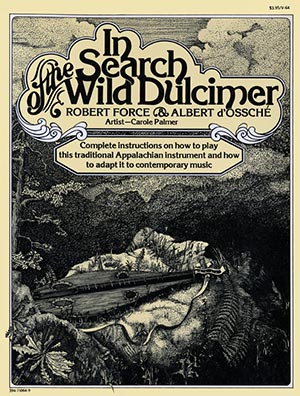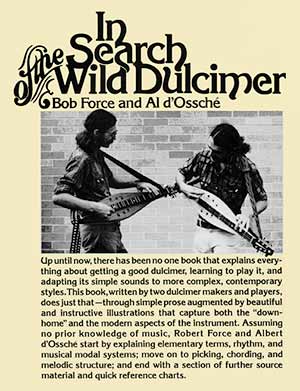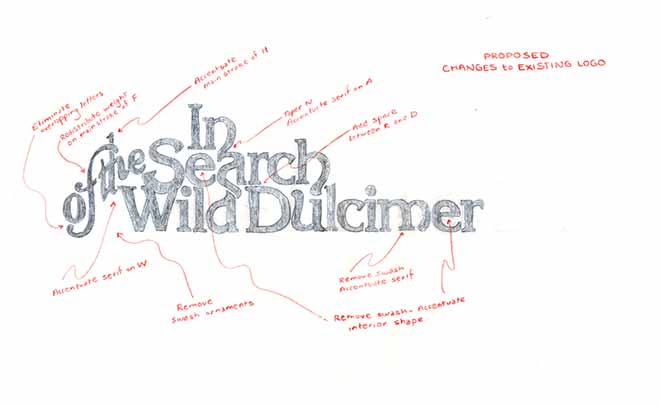In Search of the Wild Dulcimer
Over these past 40 years, with over 100,000 copies in print and countless internet hits on the electronic version, this book has proven to be one of the best teaching tools about the dulcimer, its history and on folk modal music yet written. It was not only a first for its time but it has also stood the test of time. It is available on these webpages as an electronic reference as well as-- for the first time since its publication-- in downloadble PDFs that reproduce the original, page-by-page layout of the book.
be one of the best teaching tools about the dulcimer, its history and on folk modal music yet written. It was not only a first for its time but it has also stood the test of time. It is available on these webpages as an electronic reference as well as-- for the first time since its publication-- in downloadble PDFs that reproduce the original, page-by-page layout of the book.
Here's how that came about:
When I started playing the dulcimer I didn't know anything about it-- or even that was a traditional US folk instrument. There was very little written about or recorded on the dulcimer in 1966-- certainly not in the Pacific Northwest when and where I began this adventure. In society as a whole it was a time of question and discovery. I truly hungered for a task that was both intellectual and an artistic challenge. There was no internet or other fast ways to gather information. Using trial and error, I experimented with the dulcimer, seeking the nature of sound. That process shaped my life journey.
The simple, enchanting, captivating diatonic harmonies inherent in the laws of Pythagorean harmony made the traditional dulcimer a teaching tool-- a way for me to understand music. Modes, tunings, string thicknesses, shapes, woods-- they all presented different things to know, tasks to learn, mysteries to unravel. I began keeping notes of my experiments and discoveries while teaching myself to play.
In 1971 I careened into Albert d'Ossche' at the Union Grove Fiddler's Convention in North Carolina. Of the 50,000 people in attendance, we were the only two dulcimer players. He played on his lap. He used his right forefinger for rhythm and fretted melodies with his left thumb using the traditional tuning g-g-C. By then I had developed a highly rhythmic, stand up, overhand style. I wore the dulcimer with a strap, like a guitar. I used the left-hand thumb only for bracing and tuned the dulcimer to "open" d-a-D.
 Al was a trained historian. He wanted to learned how to play the way I did and had both the dedication and the intellectual training to push me into articulating how I did what it was I was doing. We began a 20-year collaboration, the first steps of which were me showing him techniques and he applying them. I moved to his basement on Biltmore Street in Washington, DC and began writing the book.
Al was a trained historian. He wanted to learned how to play the way I did and had both the dedication and the intellectual training to push me into articulating how I did what it was I was doing. We began a 20-year collaboration, the first steps of which were me showing him techniques and he applying them. I moved to his basement on Biltmore Street in Washington, DC and began writing the book.
Like many first time writers I could barely focus. There was too much to do and too many distractions. Came the grand idea: move to Munich, Germany and write it where I didn't speak or read the language. The day-to-day would be free of English bombardment. Mirja Heinonen invited me to her apartment by the Isar River, across from Englischer Garten. There I wrote and demonstrated. Albert queried and applied. We also began to develop a unique sound with our “doubled” dulcimers.
My deal was simple: I would write it but he had to get it published. A prep school graduate, that type of thinking was second nature to him. Of course! Stateside six months later we found an illustrator, Carole Palmer, who truly illuminated the text. Next we researched who published books of this nature and came up with the Vintage Books division of Random House. Albert walked it in to the 14th floor.
He placed the script on the desk of Susan Bolotin, then a junior editor. She said if she could learn to play over the weekend she would pitch it to her boss, Bennett Cerf. She could and she did. Cerf told her that if she made the book go she would get a promotion; if not, then back to the windowless room. Susan waited for the best staff designer to come up in rotation and slotted the production with him.
He designed it in a large format, using sepia-tone Corinna type for the first time in any publication. It was also the first time Random House had published a music book. They called the owner of Manny's, the largest guitar store in New York and asked if he could sell a book like this. Manny Goldrich said, “Sell them? I'll take a thousand tomorrow!” Originally slotted for a run of 5,000, Random House kicked it up to 25,000. Susan got two inches of ink in Publisher's Weekly and it was off and running.
This was in the summer of 1972. It took over two years for the book to get to the shelves. In addition to the moderate number of rewrites and illustration coordinations, the day the book was to be printed the factory burned down! No kidding. An alert pressman literally gathered up the galleys-- the lay-outs from which the book is shot-- and ran out the door with them. (I still have the smoke-smudged originals.) When it again returned to the presses the industry was hit with a trucker's strike. The “Christmas book” market didn't get their copies until late November of 1974. But like Manny had prophetized-- it made no difference and they still quickly sold out.
This led to subsequent Random House printings and the “resale” of the book into the music trade industry. Music Sales Corporation, publisher of the Oak imprint, brought it out in numerous editions. All told, over a 100,000 copies were sold over a twenty-year period. Every copy was labeled a first edition. The “true” first editions, the initial 25,000, don't contain the name of John Servais, the photographer who shot the back cover. As well, in the foreword, the word, people, is misspelled as prople. Both of these were corrected in later editions-- though all printings say “first”.
Ahead of our time, Albert and I had the foresight to retain the electronic distribution of the book. This was before there was any such possibility. Random House readily granted that clause. As a consequence, In Search of the Wild Dulcimer has been available on the web for almost twenty years. John Griffin and Chris Martin were instrumental in this effort. In fact, some of the earlier electronic versions Chris and I made came out in (antediluvian!) hypercard stack format. There seemed to be no sense in rewriting the codes for the current web version. It exists and still functions. “If it ain't broke-- don't fix it.” So be it. Help yourself to it's use.
If a book is no longer available for purchase from the original publisher, the artists have the right to ask for the return of the copyright. Albert and I did so in the late 80's. In 1992, after Albert's passing, the rights (along with the black line proofs, the original art and the smoke-smudged galleys were all returned to me. This website contains the original book both as web-viewable and in cleaned, downloadable PDFs carefully scanned by George Bigley. It was-- and still is-- a beautiful book. Be sure to see it in its original layout with the integrated drawings. Or print it out if you want.
One of the major reviews the book received appeared in the New Age Journal. That review is reproduced here on this website. It certainly helped with the initial sales and effectively cross-marketed the book (and subject) from not being just about folk music but rather to being about self-help and self discovery-- big topics of the time. As for the big bucks, Al and I split 25 cents a book. With one royalty check my wife, Janette, and I bought a mattress. We certainly had the use of that long after the checks stopped coming.
Vintage declared in big type on the front cover: “Complete instructions on how to play this traditional Appalachian instrument and how to adapt it to contemporary music.” All still true. The years have indeed treated the book and our collaborative efforts kindly. Oh, those bright, young kids! The future was shining in their eyes.

